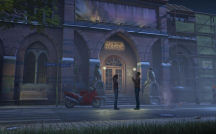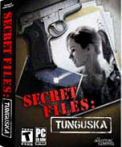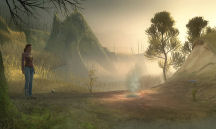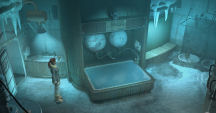By Looney4Labs
Factoid: The Tunguska
event stands out as one of the rare large-scale demonstrations that a full
doomsday event is a real possibility for the human race.*
I fancy games based on real events, so it was with great anticipation
that I
approached Secret Files: Tunguska. This game sets the tale of a
daughter seeking her vanished father into the frame of the still
unexplained 1908 explosion in the Tunguska region of Siberia. Though that
blast destroyed 2300 square miles of forest and was heard 600 miles away,
its cause has yet to be determined. Many scenarios have been put forth,
but none have been universally accepted as truth. Is that about to
change?
Tunguska intrigues immediately with
its spooky beginning. Mysterious hooded figures, shadowy scenes and
swelling orchestral music are juxtaposed with our modern, jean clad
protagonist, Nina, arriving at Berlin’s
Naturkunde Museum. She finds -- not her father, Vladimir Kalenkov, as
expected -- but a ransacked empty office. Naturally she calls the
police. Receiving very little help, she begins her quest to find her
father.
This inquiry
brings Nina into contact with many quirky and enigmatic characters and
draws her to diverse and far flung places. The multilayered story is well
developed, intertwining bits and pieces of Vladimir’s hidden history with
a possible solution to this century old mystery.
Factoid: Over the next few days, night skies were aglow
such that one could read in their light.*
Graphics
Tunguska is a beautiful game, featuring clear, crisp and
detailed graphics. Subtle movements abound. Leaves gently rustle outside
a window and bubbles rise in a sparkling aquarium. An air vent
vibrates slightly. Ceiling fans lazily turn,
dust motes drift in the sunlight, a butterfly flits from bush to bush, and
willows sway pleasingly.
The cinematic cut scenes can be replayed from the main menu. I
particularly appreciate this feature as I often miss part of a scene due
to real life interruptions. I particularly enjoyed watching Nina stroll
along the roof of a speeding train.
Avatars move fluidly, but at rest they are a bit static. While waiting
and during conversations they are still. No weight shifting, no foot
shuffling, and not much arm or head movement. More incidental movements
would have contributed to greater realism.
This game encompasses many
locations and I found something to like in all of them. In one, I noted
with humor a computer plugged into a power strip identical to mine. The
tropical colors in another were gorgeous, while the verdant and muted
colors of a misty isle invited me to stay awhile. The eerie blue lighting
in a swamp built tension. Shadows are appropriate and add authenticity.
Factoid: In the United States, the Smithsonian
Astrophysical Observatory and the Mount Wilson Observatory observed a
decrease in atmospheric
transparency that lasted for several months.*
Characters
Nina meets many folks during this journey, some helpful, some
indifferent, and some covertly antagonistic. Graphically they are all
well done. Faces are beautifully drawn and detailed with speech usually
being synchronized to text.
Nina is the main adventurer and the one you’ll spend the most time
with. I relish that Nina is a motorcycle mechanic -- an unusual
profession for a woman, at least in my neck of the woods. She sports blue
jeans, a pony tail, and an attitude.
You occasionally play as Max, a handsome, young, casually dressed
colleague of Nina’s father. I enjoyed playing as Max much more than as
Nina. For a while you alternate between Nina and Max, cooperating to
solve one puzzle. At other times the two separate to follow the trail of
clues.
But Nina and Max are just the most prominent personalities.
Tunguska is filled with non-player characters (NPCs). Some reflect
tried-and-true stereotypes, while others are more original. The furtive,
black cowled figures are appropriately ominous. I was quite intrigued by
the slight window reflection of Nina’s mysterious and malevolent foe
directing his minions from his modern skyscraper. And having an NPC seen
only from the knees down is a first for me.
Though players who love
interaction (count me among them) should get their fill in this one, it
doesn’t feel excessive. Instead, this game dispenses a nice balance of
dialogue and single player exploration.
Factoid: “I suddenly saw that directly to the North….. the
sky split in two and fire appeared high and wide over the forest.” S.
Semenov, eyewitness.*
Voice Acting and Dialogue
Great graphics are not enough to sustain a characterization for the
duration of a game. The portrayal must be completed by believable voice
acting, expressing credible emotions. I wish I could tell you that is
what I found in Tunguska. But sadly, I can’t.
This is the first game I’ve played which allows access to the
protagonist’s thoughts. This appealed to me as I believed it would allow
me to really identify with Nina, immersing myself in her personality as
well as in her quest. In practice, however, it turned what should have
been an outstanding game into merely a good one. Not because it is a bad
idea per se, but because her ruminations were too often inappropriately
flippant either in tone, content, or both.
Because of this I had a difficult time losing myself in this game.
Each time I began sinking into the story, believing it and connecting
emotionally to the characters, out popped an ill-suited utterance. Too
often, it was a witticism that fell flat or a wisecrack spoken in an
upbeat, perky tone. I never heard the tenseness, the stress, the
sincerity expected in one seeking a lost (possibly dead) father in
dangerous surroundings. I wanted to care. I wanted to connect, but the
tone of voice and too often, the words themselves broke that tenuous bond
between gamer and heroine.
It’s not all bad news. Some of the characters -- Morangie in
particular -- did a decent job bringing their personas to life. But too
many missed the high mark set by the other elements of the game.
Be aware that Tunguska
contains a smattering of mild profanity.
Factoid: All villagers were stricken with panic and took to
the streets, women cried, thinking it was the end of the world. Sibir
newspaper, July 2, 1908.*
Ambient Sounds and
Background Music
The ambient sounds are drawn with a fine and subtle hand. For the most
part they work wonderfully, establishing a realistic feeling. Traffic
sounds are in the right places. Stairs creak, dogs bark, insects chirp,
and birds sing. Once, an emergency siren caused me to remove my
headphones to verify that this alarm came from the game and not from my
environment. However, I missed the sound of footsteps. I don’t believe
that I heard them even once throughout the game.
I particularly enjoyed the background music in this game as much as for
what was absent as for what was present. During much of the game, there
is no music. This allowed me to explore in more natural surroundings,
accompanied only by environmental sounds. I enjoy that approach as it
enhances realism.
Music is present from time to
time and runs the gamut from chanting monks to Latin salsa. It provides
background, establishes flavor, and then quietly floats away.
Factoid: Amongst the many discredited theories is that of
Russian geologist Vladimir Epifanov and German astrophysicist Wolfgang
Kundt who suggested that the explosion was of methane gas emitted from the
earth.*
Puzzles
Tunguska is an inventory lover’s dream. Most of the puzzles are
inventory based and (in so far as we are talking about a game) fairly
logical and entertaining. Of course, there are always exceptions. I
learned to begin with pragmatic inventory combinations. If those failed,
I resorted to more, shall we say, “imaginative” blends. This approach
often generated an unexpected amalgamation, thus setting me on the correct
trail once again.
Though the great preponderance of puzzles in this game involve
inventory, there are also some very enjoyable logic and/or riddle types.
Nearly all are diverting and flow naturally from the story. The most
difficult one for me was the compass puzzle because its clues were too
obtuse. On the other hand, I thought the statue puzzle very clever and
absolutely satisfying.
There are no sliders, mazes,
sound or color puzzles, and nothing is timed. There are no mini-games.
Taken as a whole, the puzzles are fun and lie in the easy to mid range of
difficulty.
Factoid: Another controversial theory was advanced in 1990
by César Sirvent. He proposed that a deuterium comet may have exploded as
a natural hydrogen bomb.*
Interface
Tunguska is a point and click adventure story told from the
third person perspective. The interface is easy to use as long as one
remembers to left click to move Nina and right click to examine items. It
features a “smart cursor.” Right clicking skips dialogue and introductory
screens. Double clicking moves Nina immediately from one scene to the
next.
Saving is easy, unlimited, available at any time, and the game confirms
the save was successful. It also reminds you to save before quitting.
Saves are identified by a screen capture, a title, and the date and time.
The options menu allows adjustments to music and sounds independently,
but not voice. It also allows some customization of the graphics and
provides a game help option. With this option on, a hint is available for
a few of the game’s non-inventory puzzles. This is not a solution -- just
a gentle push in the right direction.
Captions can be turned on or off. The game was intermittently Alt+Tab
friendly. Most of the time I could tab out and back, but sporadically, I
couldn’t.
Tunguska provides hot spot help in the form of a magnifying
glass icon which they term the “snoop key.” When used it shows all exits
and all hotspots, effectively eliminating pixel hunting. Now and then,
finding that elusive spot in what I thought was a “completely searched”
scene was just the nudge I needed.
An automatic journal records important events. You can access the
journal whenever you like. To solve one puzzle, you must access the
journal, a fact which I found aggravating.
Tunguska comes with a
small paper manual. Although the “read me” file says there is a manual in
PDF format on the game disk, I was never able to find it. The game disk
must be in the drive to play.
Factoid: Yet another theory was advanced in 1965 by Cowan,
Atluri, and Libby who suggested that the Tunguska event was caused by the
annihilation of a chunk of antimatter falling from space.*
Problems
I had a problem with voices occasionally switching from normal to a
kind of “far off echo” mode. It happened with several different persons
and in multiple settings.
Other than the irregular sound flaw and Alt+Tab difficulties, the game
loaded easily and ran glitch free. A
patch addresses some issues and
provides a longer ending, but it did not fix my problems.
I did not care for the longer
ending as it echoed the frivolous irreverence found in much of Nina’s
inner musings. My biggest problem with Tunguska is that the game
could not seem to make up its mind if it was a tension-filled drama or a
comedy. The newly patched ending reinforced this dichotomy.
Factoid: The Tunguska explosion has often been referred to
in popular culture including Star Trek (original series), the 1984 film
Ghostbusters, the 2004 film Hellboy, and a 2004 Alan Parson’s album.*
In Conclusion
I liked this game. A lot! The graphics are great, locales
fascinating, the interface is intuitive, and the multilayered story is set
against a genuine mystery. Saves are at will and unlimited. The ambient
sounds are convincing and the background music is pleasant. It features
lots of people to interact with, so this is not a lonely journey.
The challenges are congenial and, with one or two exceptions, not
daunting as long as you remember to think outside the box. My
disappointment in the dialogue and voice acting is overridden by the
overall excellence of the game. It was stable, requiring no fiddling to
run. All in all, Secret Files: Tunguska was a fun time, and I look
forward to the sequel projected to release in 2008.
Grade: B+
Short List
3rd person,
mouse-controlled adventure game
Craftily designed plot
Saves unlimited and available
at will
Easy to use interface
Smart cursor
Captions available
Hot spot finder
Automatic journal records major
events
Paper manual
Excellent graphics
Filmic cut scenes
Liberal dialogue containing
mild expletives
Interaction with many
non-player characters
Dialogue not appropriate to the
tenseness of the story
Mediocre voice acting
Ambient sounds good except for
the absence of footsteps
Background music intermittent
and varied
Puzzles mostly inventory with a
few logic
No mazes, sound or color
puzzles
No timed elements
No mini-games
Patch addresses a known puzzle
issue
Intermittent Alt+Tab and sound
fading problems
Stable game
My computer specs:




